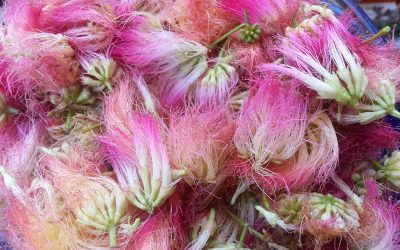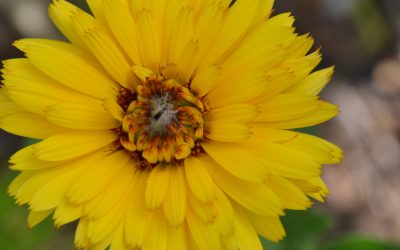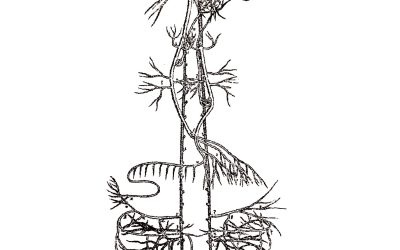Rising from the Desert Mountain: Herbs of the Sandias
by Dara Saville
Standing in the center of New Mexico is a mountain range unlike any other. The Sandia Mountains and their southward extension of fault block uplift known as the Manzano Mountains are a unique amalgam of several distinct bioregions from the surrounding physiographic areas. They are a crossroads standing at the heart of the Southwest with representative flora from all of the neighboring ecosystems. A s such, the Sandias are home to a wide range of plants from differing ecologies and environments that come together outside my urban home in Albuquerque. The vitality of this place has a heartbeat all its own and provides a home for some of my favorite plants including the incredible endemic Coral Bells Alumroot (Heuchera pulchella).
s such, the Sandias are home to a wide range of plants from differing ecologies and environments that come together outside my urban home in Albuquerque. The vitality of this place has a heartbeat all its own and provides a home for some of my favorite plants including the incredible endemic Coral Bells Alumroot (Heuchera pulchella).
Standing on a rocky outcrop near the 10,678 foot crest overlooking the sprawling city of modern Albuquerque, misty clouds enshroud the the mountain face below while clear blue sunny skies expand above. My feet are standing on Pennsylvania Period rocks that hold the secrets of the ancient seas and the fossilized remains of life before earth ever dreamed of man. Clusters of bright pink Coral Bells blossoms rising from the 300 million year old gray limestone enliven the scene around me and I am filled with awareness of how special this place is. How fortunate I feel to be an herbalist  in a location where disparate worlds come together to create a place like no other. This is a landscape with a continuous human history of varying cultures dating back to the earliest of times: nomadic Paleo hunters visiting nearby caves and playas, Pueblo farmers from all directions coalescing along the fertile lands of the Rio Grande flood plain, Great Plains traders and raiders passing through, Hispanic migrants coming up the valley from Mexico, and Anglo settlers transversing the continent from the east. It is also a place where plant life from the surrounding physiographic provinces converge to create a truly unique environment made up of representatives from the Great Plains to the east, The Rocky Mountains to the north, the Colorado Plateau to the northwest, and the Chihuahua Desert of the Basin and Range to south. This is Sandia Mountain, my home wilderness in the center of the Southwest.
in a location where disparate worlds come together to create a place like no other. This is a landscape with a continuous human history of varying cultures dating back to the earliest of times: nomadic Paleo hunters visiting nearby caves and playas, Pueblo farmers from all directions coalescing along the fertile lands of the Rio Grande flood plain, Great Plains traders and raiders passing through, Hispanic migrants coming up the valley from Mexico, and Anglo settlers transversing the continent from the east. It is also a place where plant life from the surrounding physiographic provinces converge to create a truly unique environment made up of representatives from the Great Plains to the east, The Rocky Mountains to the north, the Colorado Plateau to the northwest, and the Chihuahua Desert of the Basin and Range to south. This is Sandia Mountain, my home wilderness in the center of the Southwest.
Coral Bells occupies the heart of this varied and ancient kingdom. Perched upon the highest peak in the area, she sits on top of the world claiming her title as Queen of the Crossroad. Coral Bells is a rare plant known to exist only within the Sandia and Manzano Mountains. It favors the habitat characteristic of Sandia Mountain which has a abundance of rough limestone outcrops along with cooler, wetter conditions along the crest. This species can also be found at lower elevations on the mountain when other habitat requirements are met. This plant’s fuzzy pink flowering spikes and scalloped leaves soften the rugged landscape of the crest and provide a softness to its rocky cliffs. Aside from its special status as an endemic plant, it is also a locally known herbal medicine. Since this species is a rare endemic plant, only the more common but closely related species of Alumroot H. parviflora can be gathered for medicine. As one of the stronger astringent herbs available in our region, Alumroot makes an excellent remedy for stomach flu, diarrhea, mouth sores, sore throats, and skin irritations. The whole plant is medicinal with the roots being the strongest in action.
 Alumroot is not alone on this sacred mountain. Each of the ecozones invites a new range of plants to make their homes. Near the crest and intermingling with Alumroot in the Subalpine or Spruce-Fir zone above 9,800 feet, I often find the monumental beauty of Green Gentian (Frasera speciosa). Like other Gentians this plant is known for its bitter properties and helpfulness with all kinds of digestive issues for which it is usually prepared as a fresh root elixir or tincture. Young Green Gentian plants spend their early years as a rosette, often waiting many years before growing their tall flowering stalk. To see such a magnificent stalk laden with small white-green flowers is a powerful sight, like a sentinel rising up out of the forest. Yet it comes with the understanding that this is Green Gentian’s final bow before completing its life cycle.
Alumroot is not alone on this sacred mountain. Each of the ecozones invites a new range of plants to make their homes. Near the crest and intermingling with Alumroot in the Subalpine or Spruce-Fir zone above 9,800 feet, I often find the monumental beauty of Green Gentian (Frasera speciosa). Like other Gentians this plant is known for its bitter properties and helpfulness with all kinds of digestive issues for which it is usually prepared as a fresh root elixir or tincture. Young Green Gentian plants spend their early years as a rosette, often waiting many years before growing their tall flowering stalk. To see such a magnificent stalk laden with small white-green flowers is a powerful sight, like a sentinel rising up out of the forest. Yet it comes with the understanding that this is Green Gentian’s final bow before completing its life cycle.
Moving down the mountain to the mixed conifer zone from 9,800 to 8,000 feet, we enter the domain  of Figwort (Scrophularia montana), another plant endemic to New Mexico. This is a plant I have come to know and love, not for its elegance or beauty, but rather for its reliability. Regardless of wet years or dry years, Figwort always grows in abundance on Sandia Mountain. I love this plant’s ability to heal chronically inflamed skin, whether from recurring athlete’s foot, diaper rash, bed sores, eczema, or psoriasis, Figwort heals it all. The infused oil made from wilted leaves and flowering tops has a wonderful nutty aroma and when used topically, soothes irritated skin, heals wounds, and strengthens the skin tissue at the cellular level. Fresh herb tincture can also be prepared and used internally as part of the same treatments.
of Figwort (Scrophularia montana), another plant endemic to New Mexico. This is a plant I have come to know and love, not for its elegance or beauty, but rather for its reliability. Regardless of wet years or dry years, Figwort always grows in abundance on Sandia Mountain. I love this plant’s ability to heal chronically inflamed skin, whether from recurring athlete’s foot, diaper rash, bed sores, eczema, or psoriasis, Figwort heals it all. The infused oil made from wilted leaves and flowering tops has a wonderful nutty aroma and when used topically, soothes irritated skin, heals wounds, and strengthens the skin tissue at the cellular level. Fresh herb tincture can also be prepared and used internally as part of the same treatments.
Entering the Ponderosa-dominated Pine Forest zone ranging from around 8,200 to 7,500 feet,  Sandia mountain makes way for my beloved Blue Vervain (Verbena macdougalii). Common throughout this middle elevation belt of the Sandias, Blue Vervain is a plant with both beauty and functionality. This plant’s silvery green leaves and purple flowering spikes captured my attention many years ago and has remained at the heart of my practice ever since. This plant radiates a calming energy that invites a meditative sit in the woods. As an excellent antiviral, sedative, and bitter, I regularly rely on this herb’s medicine in the form of dry herb tincture. Whenever I have that indescribable ‘off-feeling’, like I might be coming down with something, I turn to strong and frequent doses of Echinacea and Blue Vervain. This almost always wards off whatever malady was developing, leaving me with scarcely noticeable fleeting symptoms. Blue Vervain also works well in formulas for folks who will not rest themselves when ill or for people whose digestive upsets negatively impact their sleep.
Sandia mountain makes way for my beloved Blue Vervain (Verbena macdougalii). Common throughout this middle elevation belt of the Sandias, Blue Vervain is a plant with both beauty and functionality. This plant’s silvery green leaves and purple flowering spikes captured my attention many years ago and has remained at the heart of my practice ever since. This plant radiates a calming energy that invites a meditative sit in the woods. As an excellent antiviral, sedative, and bitter, I regularly rely on this herb’s medicine in the form of dry herb tincture. Whenever I have that indescribable ‘off-feeling’, like I might be coming down with something, I turn to strong and frequent doses of Echinacea and Blue Vervain. This almost always wards off whatever malady was developing, leaving me with scarcely noticeable fleeting symptoms. Blue Vervain also works well in formulas for folks who will not rest themselves when ill or for people whose digestive upsets negatively impact their sleep.
Ranging among both the Pine Forest and Pinon Juniper Belt (6,000-7,500 feet), Pedicualris centranthera has been one of my favorite plants since the beginning. Also known as Wood Betony or  Lousewort, this little plant is often overlooked. It blooms early in the season, often reaching out above the last spring snows, and by the time summer’s heat arrives, its leaves are shriveling up and disappearing. This is a plant that captures the attention of the springtime hiker. For those on the mountain at this time of year, you will be rewarded with a glimpse into one of the most striking flowers as well as a chance to harvest one of our best muscle relaxant medicines. I often find Pedicularis centranthera‘s tiny fern-like leaves and diminutive but brightly colored magenta and white flowers peeking out of pine needle mulch or rocky outcrops in these lower elevations on Sandia Mountain. This plant works well as a fresh herb tincture of leaves and flowers and also as an infused oil or salve for sore muscles and tension held deeply within the body. (Read my full-length post on Pedicularis.)
Lousewort, this little plant is often overlooked. It blooms early in the season, often reaching out above the last spring snows, and by the time summer’s heat arrives, its leaves are shriveling up and disappearing. This is a plant that captures the attention of the springtime hiker. For those on the mountain at this time of year, you will be rewarded with a glimpse into one of the most striking flowers as well as a chance to harvest one of our best muscle relaxant medicines. I often find Pedicularis centranthera‘s tiny fern-like leaves and diminutive but brightly colored magenta and white flowers peeking out of pine needle mulch or rocky outcrops in these lower elevations on Sandia Mountain. This plant works well as a fresh herb tincture of leaves and flowers and also as an infused oil or salve for sore muscles and tension held deeply within the body. (Read my full-length post on Pedicularis.)
Below the Pinon Juniper Belt are the Foothills, which provide habitat for many of our dryland  medicine plants including Globemallow (Sphaeralcea angustifolia and the ground cover species S. coccinea). Globemallow has long been a favorite desert wildflower of mine with its uniquely orange-colored flowers blooming all summer long and creating a grand-finale burst of color for late summer and early autumn. Most of all, I have come to love this plant’ wide medicinal reach and usefulness in so many herbal formulas. Globemallow tonifies the immune system, heals soft tissue, reduces inflammation, and is especially helpful in cases involving auto-immunity. Being highly water soluble, I prepare the leaves and flowers as a hot infusion and the mucilage-rich roots as a cold infusion. For convenience and use in formulas, a tincture can also be prepared from the tea.
medicine plants including Globemallow (Sphaeralcea angustifolia and the ground cover species S. coccinea). Globemallow has long been a favorite desert wildflower of mine with its uniquely orange-colored flowers blooming all summer long and creating a grand-finale burst of color for late summer and early autumn. Most of all, I have come to love this plant’ wide medicinal reach and usefulness in so many herbal formulas. Globemallow tonifies the immune system, heals soft tissue, reduces inflammation, and is especially helpful in cases involving auto-immunity. Being highly water soluble, I prepare the leaves and flowers as a hot infusion and the mucilage-rich roots as a cold infusion. For convenience and use in formulas, a tincture can also be prepared from the tea.
Back down in the Rio Grande Valley below, more wild medicine habitat expands across the desert plain to the Cottonwood Bosque along the life-giving river. To look back up at Sandia Mountain from here gives one a view of the depths of the earth as these fault block uplifted mountains expose the deepest, oldest Precambrian rock along its dramatic western face. I fall in love with this mountain all over again as I take in the ancient wisdom from earth’s earliest days. I am content to live in this sacred medicine-filled landscape; to live in the heart of the Southwest along with Coral Bells, Queen of the Crossroads.
blank
Note
This essay was originally published as: Saville, Dara. (October 2014). Alum Root and Allies. Herbaria, 5(1), 6-10.





